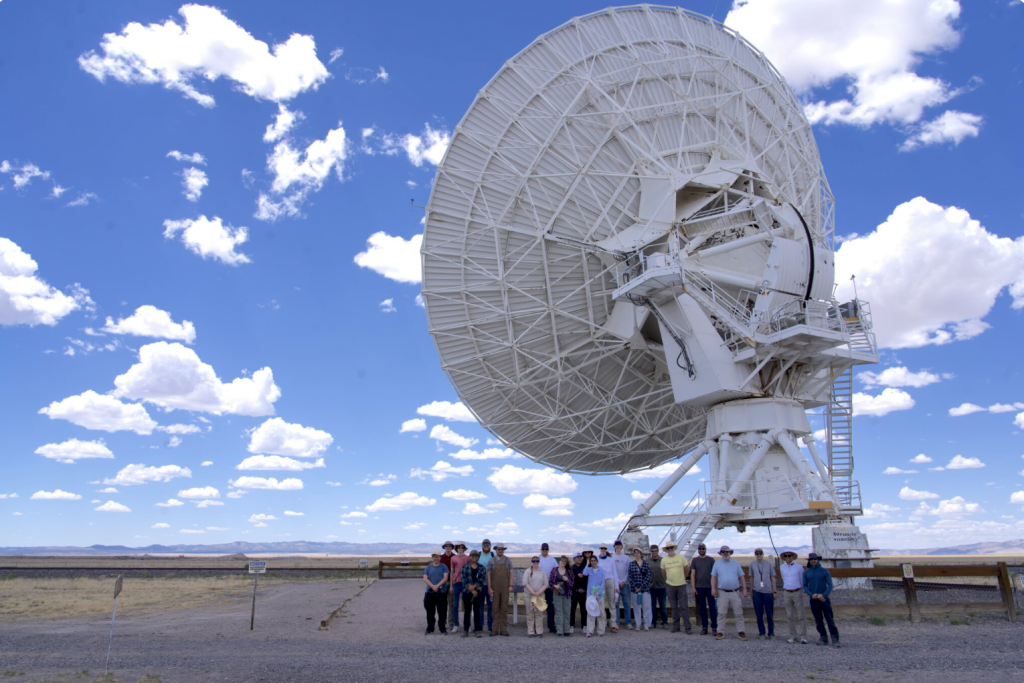The U.S. National Science Foundation National Radio Astronomy Observatory (NSF NRAO), in partnership with several leading Mexican universities and research institutes, has announced a series of landmark agreements and meetings aimed at advancing Mexico’s role in the Next Generation Very Large Array (ngVLA) project.
Recent News
Astronomers Discover a Superheated Star Factory in the Early Universe
Astronomers have uncovered a previously unknown, extreme kind of star factory by taking the temperature of a distant galaxy using the ALMA telescope. The galaxy is glowing intensely in superheated cosmic dust while forming stars 180 times faster than our own Milky Way.
Astronomers Share Largest Molecular Survey To-date: GOTHAM Legacy Data Goes Public
Astronomers in the “GBT Observations of TMC-1: Hunting Aromatic Molecules” research survey, known as GOTHAM, have released a spectral line survey with largest amount of telescope time ever conducted, charting more than 100 molecular species only found in deep space.
NSF NRAO Hosts SpectrumX Field Experiment at the Very Large Array

The U. S. National Science Foundation’s National Radio Astronomy Observatory (NSF NRAO) recently collaborated with NSF SpectrumX, the Spectrum Innovation Center, to host a large-scale spectrum research experiment at the U.S. National Science Foundation Very Large Array (NSF VLA) in New Mexico.
This week-long effort, conducted in July 2025, brought together researchers, students, and experts from across academia, government, and industry to study spectrum usage in the 7.125 to 7.4 GHz band—frequencies of increasing importance to both science and emerging sixth-generation (6G) communications. Because of the unique sensitivity of the NSF VLA, the experiment provided a vital opportunity to explore how future spectrum allocations may affect radio astronomy and other passive scientific applications. Read the full release.
About NRAO
The National Radio Astronomy Observatory is a facility of the U.S. National Science Foundation, operated under cooperative agreement by Associated Universities, Inc.
Contact:
Corrina C. Jaramillo Feldman, Senior Public Information Officer
National Radio Astronomy Observatory
[email protected]
(505) 366-7267
public.nrao.edu
About SpectrumX
SpectrumX is funded by the NSF as part of its Spectrum Innovation Initiative, under grant number AST 21-32700. SpectrumX is the world’s largest academic hub where all radio spectrum stakeholders can innovate, collaborate, and contribute to maximizing social welfare of this precious resource.
To learn more about SpectrumX, please visit spectrumx.org.
Contact:
Stephanie Loney, Research Communications Specialist
NSF SpectrumX / Notre Dame Research / University of Notre Dame
[email protected] / 574.631.7804
spectrumx.org
This news article was originally published on the NRAO website on September 2, 2025.
Recent News
NSF National Radio Astronomy Observatory and Mexican Institutions Sign Historic Agreements to Advance ngVLA Collaboration
The U.S. National Science Foundation National Radio Astronomy Observatory (NSF NRAO), in partnership with several leading Mexican universities and research institutes, has announced a series of landmark agreements and meetings aimed at advancing Mexico’s role in the Next Generation Very Large Array (ngVLA) project.
Astronomers Discover a Superheated Star Factory in the Early Universe
Astronomers have uncovered a previously unknown, extreme kind of star factory by taking the temperature of a distant galaxy using the ALMA telescope. The galaxy is glowing intensely in superheated cosmic dust while forming stars 180 times faster than our own Milky Way.
Astronomers Share Largest Molecular Survey To-date: GOTHAM Legacy Data Goes Public
Astronomers in the “GBT Observations of TMC-1: Hunting Aromatic Molecules” research survey, known as GOTHAM, have released a spectral line survey with largest amount of telescope time ever conducted, charting more than 100 molecular species only found in deep space.
